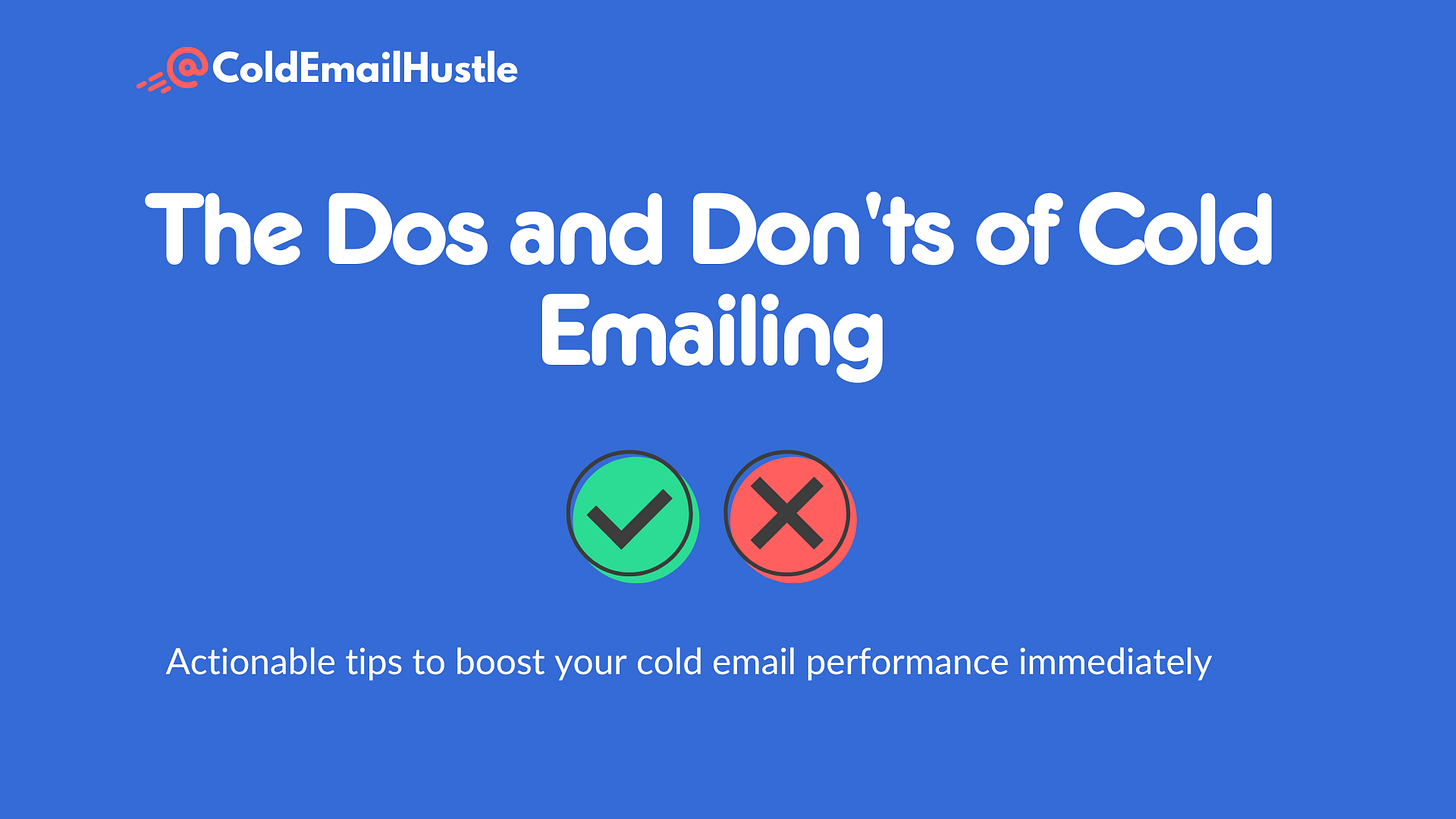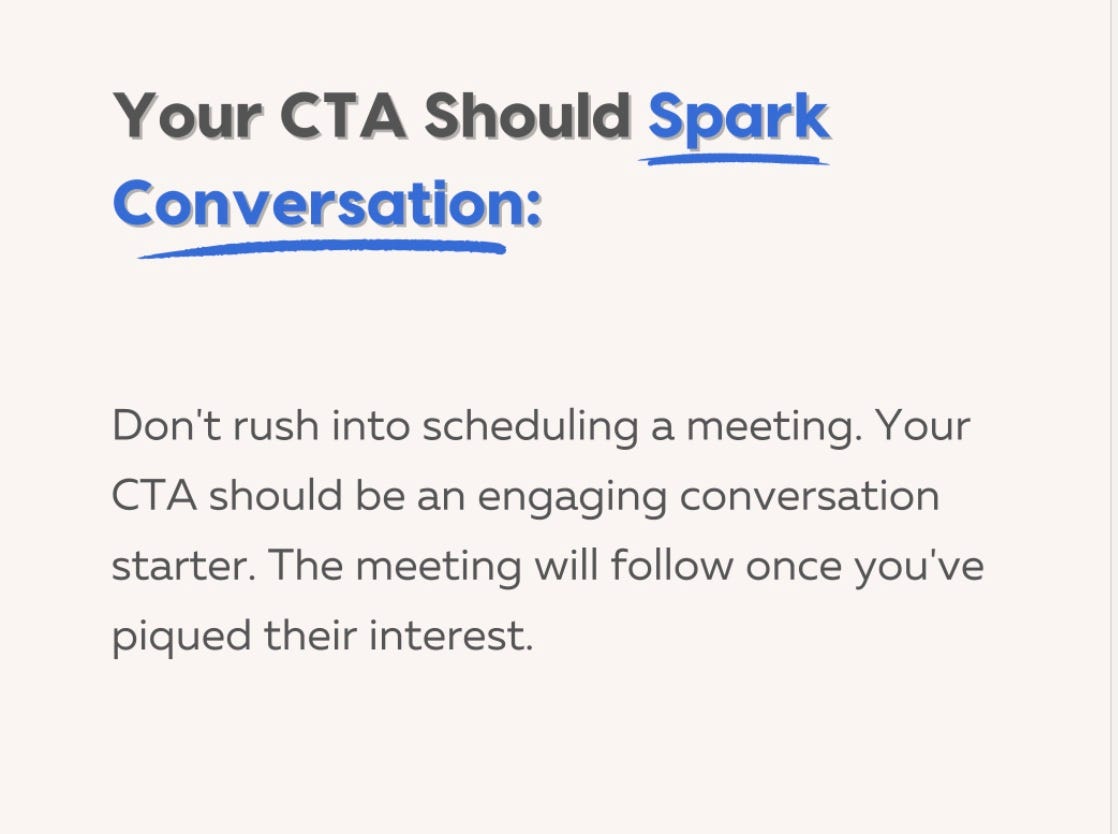The Dos and Don'ts of Cold Emailing in 2023
Actionable tips to boost your cold email performance immediately
Cold emailing. It's a term that can either fill you with a sense of opportunity or make you cringe in apprehension.
It's a marketing strategy that, when done right, can open doors to potential customers who were previously out of reach. But when done wrong, it can lead to your messages being banished to the realm of the spam folder.
So, what's the secret sauce?
How do you ensure your cold emails are received as a welcome surprise rather than an unwanted intrusion?
Let's dive into the dos and don'ts of cold emailing.
The Dos of Cold Emailing
Do Your Research
Before you even think about hitting that 'send' button, take a moment to research your potential customers. Understand their needs, their pain points, and how your product or service can provide a solution. This not only helps in personalizing your emails but also ensures you're targeting the right audience.
Here are 7 tools to help you with research:
LinkedIn: This is a great tool for researching individuals and companies. You can learn about a person's job role, their skills, and their professional background. For companies, you can learn about the company size, industry, and recent updates or news.
Crunchbase: This is a platform for finding business information about private and public companies. It provides information about funding rounds, investors, and investment trends.
Google Alerts: You can set up alerts for a company or industry to keep track of the latest news and developments. This can help you stay updated and tailor your approach accordingly.
Clearbit: This tool provides real-time intelligence that can be integrated with your CRM or customer database. It can provide insights about a company such as size, industry, location, and even the technology they use on their website.
Hunter.io: This tool helps you find email addresses associated with a particular domain. It can be useful for finding the right contact within an organization.
BuiltWith: This tool lets you find out what technology a website is built with. This can be useful if you're selling a product or service that integrates with or complements certain technologies.
ZoomInfo: This is a comprehensive contact and company database that can be used for prospecting and recruitment. It provides direct dials and email addresses for B2B professionals.
Personalize Your Emails
Speaking of personalization, this is a non-negotiable in the world of cold emailing. Addressing the recipient by their name and tailoring the content to their specific needs can significantly increase your open rates. Remember, your email should speak to them, not at them.
Personalizing emails at scale can be a challenge, but with the right tools and strategies, it's definitely achievable. Here are a few examples:
Segmentation: Divide your email list into smaller segments based on shared characteristics. This could be industry, job role, company size, past interactions with your company, etc. You can then tailor your email content to each segment. For example, you could send different emails to prospects in the healthcare industry versus those in the education industry.
Dynamic Content: Many email marketing platforms allow you to use dynamic content in your emails. This means you can automatically change parts of the email content based on the recipient's information. For example, you could use the recipient's first name in the greeting, or mention their company name in the body of the email.
AI Ice-Breaker Writing Tools: These tools use artificial intelligence to scrape information about a prospect from their LinkedIn profile, website, or other online sources. They then use this information to write a personalized introduction paragraph for your cold email. This could include mentioning a recent company achievement, a shared connection, or a common interest. This not only shows that you've done your homework, but also helps to establish a connection right off the bat. Tools like Crystal Knows, Coldlist.io, and others can help with this.
Content Template Per Niche: This technique involves creating a unique email template for each niche segment in your list. The content of each template is tailored to resonate with that specific niche. For example, if you're reaching out to prospects in the healthcare industry, your email might discuss the specific challenges of healthcare and how your product or service can help address them. This makes your emails feel like a one-to-one message, even though they're sent at scale.
Keep Your Emails Short and Sweet
In the fast-paced world we live in, time is a precious commodity. So, keep your emails concise and to the point. Ensure the most crucial information is at the top, and avoid unnecessary fluff. Your recipients will thank you for it.
Imagine you're crafting a tweet rather than penning a novel. Twitter's character limit forces us to be succinct and impactful with our words. Apply the same principle to your cold emails.
Aim for 75 words or less - a brief message that can be read in under a minute.
Use a Strong Call to Action
What's the next step you want your recipient to take after reading your email? Whether it's visiting your website, scheduling a call, or downloading a whitepaper, make sure your cold email CTA has the following 4 characteristics:
Clear
Unique
Encourages Action
Simple to perform
Here are a few tips on crafting a strong call to action:
Provide a Specific Date and Time: Make it easy for your prospect to say yes by suggesting a specific date and time for a meeting or call. For example, instead of saying "Let's schedule a time to chat!", you could say "Are you available for a quick 20-minute phone call next Thursday, Dec 16 at 10 AM EST?" This removes the burden of decision-making from your prospect and makes it easier for them to respond.
Offer Multiple Choices: Giving your prospect a choice can make them feel more in control and increase the likelihood of them taking action. For example, if you're offering a demo of your product, you could say "Would you prefer a live demo or a pre-recorded walkthrough?"
Avoid Using Links: Including links in your cold emails can increase the chances of your email being marked as spam. Instead, you can ask your prospects to reply to your email if they're interested. For example, "Reply to this email if you're interested in learning more about our services."
Track Your Results
The only way to improve is to know where you stand. Track the results of your cold email campaigns to understand what's working and what's not. Use these insights to refine your strategy and enhance your future campaigns.
Make sure you keep track of these 6 performance metrics and make appropriate adjustments:
Open Rate: This is the percentage of recipients who opened your email. A low open rate could indicate that your subject line isn't compelling enough or that your emails are landing in the spam folder.
Click-Through Rate (CTR): This is the percentage of recipients who clicked on a link in your email. A low CTR could mean that your email content or your call-to-action isn't compelling enough.
Response Rate: This is the percentage of recipients who responded to your email. If your response rate is low, it could mean that your email content isn't resonating with your audience, or that you're not targeting the right people.
Bounce Rate: This is the percentage of emails that couldn't be delivered. A high bounce rate could indicate that many of the email addresses in your list are invalid.
Conversion Rate: This is the percentage of recipients who took the desired action after clicking on your link (e.g., made a purchase, signed up for a trial, etc.). If your conversion rate is low, it could mean that your landing page isn't effective.
Unsubscribe Rate: This is the percentage of recipients who unsubscribed from your email list. A high unsubscribe rate could indicate that your emails aren't providing enough value to your audience.
The Don'ts of Cold Emailing
Don't Use a Generic Template
While templates can save time, a generic one can be the demise of your cold email campaign. It's glaringly obvious when an email has been sent to a mass list, and it's a surefire way to get your message ignored.
Invest time in personalizing your emails. It'll be worth it.
Don't Send Mass Emails
Speaking of mass emails, just don't. They're often perceived as spam and are likely to be ignored or worse, marked as spam. Instead, focus on sending targeted emails to a curated list of potential customers.
Don't Be Spammy
Spam filters are designed to keep unwanted emails out of users' inboxes. They use a variety of criteria to judge whether an email is spam, including the use of certain words and phrases.
Images below list some words and phrases that are commonly associated with spam and should be avoided in your email subject lines and content.
Don't Be Pushy
Nobody likes to feel pressured. So, avoid being overly aggressive in your emails. Instead, focus on building relationships and providing value. Remember, cold emailing is a marathon, not a sprint.
Don't Give Up
Persistence is key in cold emailing. It may take time to see results, but don't let that deter you. Keep sending high-quality, personalized emails, and you'll start to see the fruits of your labor.
Conclusion
Cold emailing can be a powerful tool in your marketing arsenal when done right. By following these dos and don'ts, you can increase your chances of success and open the door to new opportunities. Remember, at the heart of every successful cold email is value. Focus on providing that, and you're already halfway there. Happy emailing!








